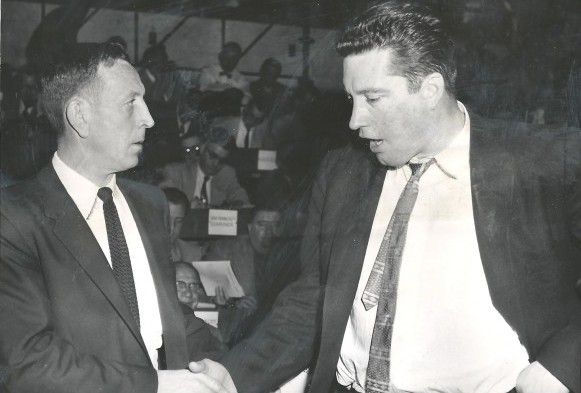
By David Eskenazi and Steve Rudman
The reporting on the March 19, 1956 NCAA Tournament game between John Woodens UCLA Bruins and Al Brightmans Seattle U. Chieftains in Corvallis, OR., leaves no doubt that the game was a tumultuous affair so much so that The Eugene Register-Guard newspaper felt moved to note that UCLAs 94-70 victory will go down in annals as one of the roughest college games in history.
From this perspective, more than 50 years later, we are in no position to agree or disagree. But the Bruins lost three of their five starters on fouls, had three other players with four, and set a tournament single-game record with 35 fouls overall.

Two near fights, plus the ejection of UCLA forward Bill Eblen after he delivered what the Register-Guard labeled a wicked blow to a Seattle U. player, lowlighted the roughhousing.
At the start of the second half, Seattle Universitys Ken Fuhrer traded haymakers with Dick Banton of UCLA. Another battle occurred with four and a half minutes to play when Eblen sought to separate Fuhrer from his senses.
Before officials could restore order, Brightman, fuming over UCLAs brutish treatment of his players, confronted Wooden, still a young man with all his hair. The two engaged in what the Register-Guard called a wordy battle on the sidelines. The Seattle Post-Intelligencer added this detail: Brightman tried to pick a fight with Wooden after the game.
Hard to imagine today anyone trying to pick a fight with Wooden, then nearly a decade away from winning the first of 10 NCAA championships, and man universally held in his later years in saintly regard.
Three days after his sideline confrontation with Wooden, Brightman, who won 180 games and lost 68 with five postseason appearances during his SU tenure, abruptly resigned. He explained that he had been planning to do so for more than a month and denied that any link existed between his decision to quit and the jawboning incident with Wooden.
There was no pressure involved in my decision, Brightman maintained.
Father Robert Rebhahn, S.J., Seattle Universitys athletic director, refused to issue an iota of explanation for Brightmans head-scratching exit.
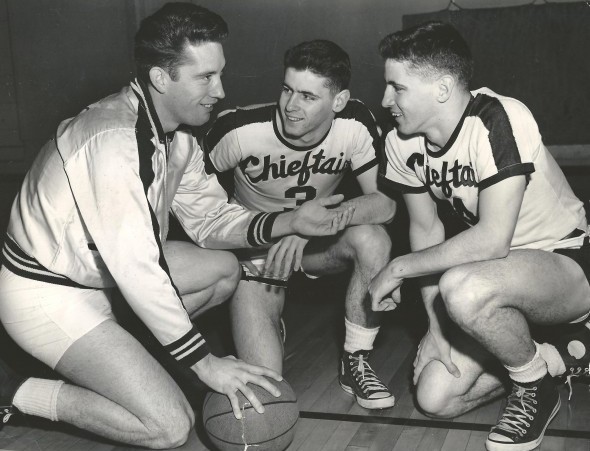
This is something I had planned for a while, Brightman said as he cleaned out his office. I want everyone here to know that it has been eight wonderful years. I have no complaints.
Asked if he had anything lined up to replace his $8,000 per year job as the schools basketball and baseball coach, Brightman indicated that he had worked out a deal to coach a semipro baseball team in Canada the following summer, but nothing beyond that.
Reporters who chronicled Seattle U. hoops couldnt help but speculate that there had to be more to Brightmans decision. Brightman was 32 and not even close to the prime of his coaching career. In eight years, he had transformed Seattle University from a regional also-ran into a school that more often than not figured in the national rankings.
Popular and handsome, Brightman seemed to have everything going for him at Seattle U, and it made no sense for him to walk away from full-time position at a Division I school to take a part-time job with a semipro baseball team in the Canadian bushes, especially since a young phenom named Elgin Baylor was scheduled to join the Chieftains the following season.
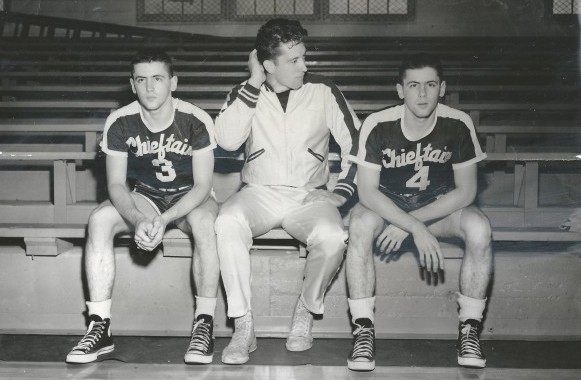
Just two years earlier, Seattle U. had published a program article about Brightman, which noted, At 30, Brightman is one of the youngest and most successful coaches in college basketball. He divides his interest in sports between coaching the Chieftains and playing basketball and baseball for various Northwest semipro teams.
Something went awry between Brightman and his Jesuit bosses in the two years since that blurb found print. But in the absence of any additional information, reporters were forced to accept Brightmans explanation.
It took a number of years for the facts to emerge, and when they did they suggested that Brightman had not resigned, but had been provided an opportunity to resign. No one ever found out exactly why Brightman and Seattle U. came to a parting of the ways.
He never said why, said Eddie OBrien, one of Brightmans most famous players and a life-long friend. He didnt want to talk about it.
He just faded into the abyss, wrote The Seattle Times.
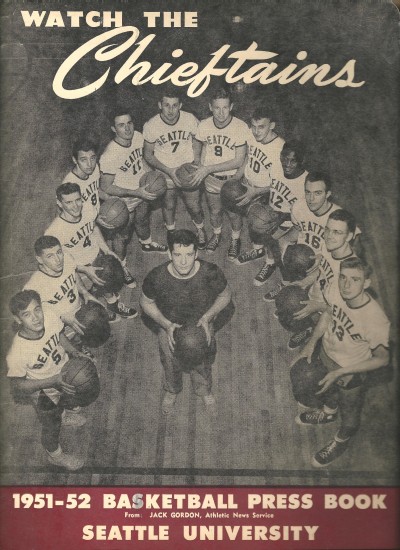
Born Sept. 22, 1923 in Eureka, CA., Horace Albert Al Brightman became Seattle Universitys head coach (hired by school president Rev. A.A. Lemieux) Aug. 21, 1948 at 24, replacing Len Yandle, who resigned to enter private business after going 10-16 in 1947-48.
An All-State basketball and baseball player at Woodrow Wilson High in Long Beach, CA. (in 1941, he averaged a city-record 22.7 points per game and was CIF Player of the Year), Brightman had a cup of coffee as a catcher in the Cleveland Indians organization as a 17-year-old (career ended when he tore up his shoulder) and later played basketball at Cal State Long Beach and Morris Harvey College (now the University of Charleston) in Charleston, WVA.
Brightman once scored 51 points in a game for Morris Harvey and averaged 25 points per game during his time at the school.
Brightman also played with national AAU champion Twentieth Century-Fox, and had a 58-game career with the Boston Celtics in 1946-47.
After averaging 9.8 points for the Celtics (became the first Celtic to score 20 points in a regular-season game), Brightman and his wife, Katie, drove west to visit his folks, who had relocated to Seattles north end. After their visit, Brightman and his wife started driving back to Boston, stopping at a motel in southern Idaho after the first days travel.
We went on our way the next morning, Brightman told The Seattle Times. We stopped for gas and I reached for my wallet. It wasnt there. We returned to the motel to retrieve it and kept right on driving west until we were back in Seattle.
So much for his career with the Boston Celtics.
A year later, while looking for regular work, Brightman joined the second-year Seattle Athletics of the Pacific Coast Professional Basketball League (see Wayback Machine: Seattle Athletics) and became the teams leading scorer and only All-League selection (The Post-Intelligencer described him as 210 pounds and rough under the boards).
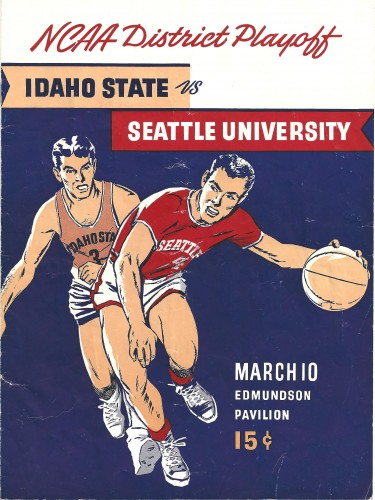
After Seattle U. employed him, Brightmans first two teams went 12-14 and 12-17. Then, for the next eight years, there was never a dull moment at Broadway and Madison, especially after Brightman recruited the 5-foor-9 OBrien twins, Johnny and Eddie, out of Amboy, NJ.
How that happened: In the summer of 1950, two years into Brightman’s stint at Seattle U., Brightman and the O’Briens played semi-pro baseball against each other in Wichita, KN.
“Al was playing first base and I got on,” Eddie recalled. “He introduced himself and said, ‘I would like to talk to you and Johnny about playing basketball at Seattle University.’ I told him, ‘I would like that, Mr. Brightman — but I just got the steal sign,’ and off I went. The next day, we got a letter from Brightman recruiting us.”
During the three years the O’Brien twins played under Brightman, the Chieftains went 90-17.
“Al Brightman changed the complexion of basketball in this area, said former Seattle U. publicity director Bill Sears. He brought in the fast break. He took the talent he had and did the most with it.”
Brightman had many successes, his most famous occurring Jan. 21, 1952, when he agreed to play the famous Harlem Globetrotters after the University of Washington declined, fearing a wipeout.
Even some of Brightmans players expressed skepticism that they could hang with the Trotters, who then were serious about their basketball, but Brightman was sure of it. For the previous two years, Brightman had played a number of games for the Madigan Generals, an independent semipro team sponsored by the Madigan Army Medical Center (Tacoma) that lined up against whatever clubs they could schedule: barnstorming pro teams, AAU outfits, college clubs.
Madigan included prominent local ex-collegians, notably former University of Washington star Sammy White (then with the Boston Red Sox), former Alpine Dairy center Bob Graf, John (Hotfoot) Katica, a former leading scorer for St. Martins College, and Marv Harshman, a football/basketball star at Pacific Lutheran then nicknamed “The Hatchet Man.”
Two years before Brightmans Chieftains played the Globetrotters, and with Brightman in the lineup, Madigan overcame a 27-18 halftime deficit and defeated the Globetrotters 40-33 in Yakima. A year later, with Brightman scoring a game-high 18 points, Madigan barely lost to the Trotters 59-57 in front of a sellout crowd a Civic Auditorium.
Two days before meeting the Trotters for the first time as a college head coach, Brightman called his Chieftains to a special Saturday practice.
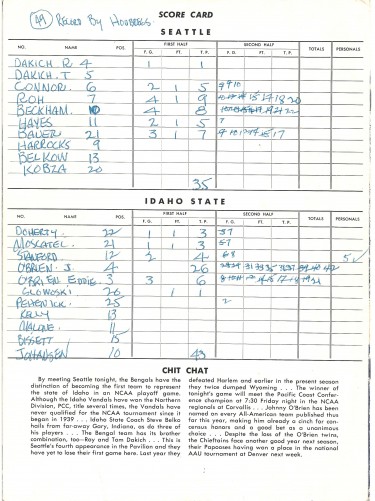
“He told us, ‘Im going to show you how to beat them. First, they seldom double team, which means theyll guard Johnny one-on-one,'” said Eddie O’Brien. “Then he told us that they were a great outside shooting team and to sit tight on their guys outside. Johnny scored 43 points and we won (84-81).”
The game made headlines across the country and helped make the OBriens All-America selections. (see Wayback Machine: Seattle U. Shocks Globetrotters).
Brightman coached many other memorable games. The following December, he took the Chieftains to Madison Square Garden for the first time and defeated New York University 102-101 in the first game in college basketball history in which both teams scored more than 100 points (Eddie OBrien had 33 points, Johnny 29).
“He was a very aggressive coach and playing for him was a great experience,” said Eddie. “You felt bad for him if you lost. But he was demanding. We practiced for an hour and a half every day and never sat down. The first day of the season at the end of practice we would have to run the gym 25 times. He’d stand there and count them, and he’d put chairs around the gym so you couldn’t cut corners. He did that until the last day of the season.
“If we were in that kind of shape, we could wear teams down. The practices were tough, the games were easy. It was great to play for him. He wasn’t much older than we were, so he was almost like one of the guys. But he was the boss. He was great to play for, but you had to play.”
Brightmans Seattle U. teams made four NCAA Tournament appearances and played once in the NIT. If Brightman had his way, the Chieftains would have made one fewer NCAA and one more NIT appearance.
Near the end of the 1953 season, having compiled a 29-4 record, Seattle U. had a choice of playing in either the NCAA or NIT. Athletic Director Bill Fenton and athletic department liaison Father Robert Carmody, S.J., opted against Brightmans advice — to play in the NCAA Tournament out of allegiance to the NCAA, and also because Seattle U. alumni and students wanted to see the Chieftains play Washington for the first time.
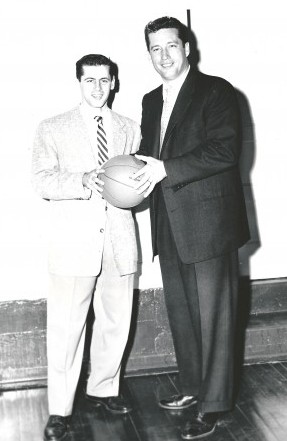
Disappointed with the decision, Brightman didn’t hide his feelings from his players, which probably didnt help his team going into the game in Corvallis. Nor did his public statements that Seattle U. should have accepted a bid to the NIT endear him to the Jesuits.
Brightman knew his chances against Washington werent that good, recalled Sears.
Coached by Tippy Dye, Washington had its best team ever (see Wayback Machine: Bob Houbregs & The 53 Final Four) and quickly proved Brightman correct. The taller Huskies, led by Houbregs, jumped to a 24-11 lead and had no trouble winning, 92-70.
Brightman actually had his best team, from a record standpoint, the year after the OBriens graduated. The Chieftains went 26-2 in 1953-54 and then 22-7 the following year, demonstrating his skill as a recruiter. But after Seattle U.s first-round loss to UCLA in the first round of the 1956 NCAA Tournament the game that included the set-to with Wooden records and rankings suddenly no longer mattered.
Nor did it matter that Brightman brought unprecedented good publicity to Seattle U., or that he had been an innovator, winning consistently with an entertaining brand of fast-break basketball when most of his coaching peers thought it highly unsound strategy.
He was successful on the court, tall, handsome, and blessed with a magnetic personality, wrote Georg N. Meyers in The Times. It was so magnetic that the Seattle Rainiers signed him as a first-base coach in 1954, and so magnetic it could become overpowering, even overbearing. Al was young, impulsive, whimsical. His off-court digressions chipped away at the on-court image.
Given the reporting standards of the day, neither Meyers nor any of his fellow scribes ever hinted at the nature of Brightman’s “off-court digressions.”
Brightmans biggest problem post-Seattle U.: He failed to get his college degree, and the schools to which he applied for coaching positions wouldnt overlook that, as Seattle U. had, no matter how impressed they might have been with what he had done for the Chieftains.
Needing money to support his growing family, Brightman took his “magnetic personality” and flair for turning a phrase, to Seattles Channel 13 six weeks after his Seattle U. exit.
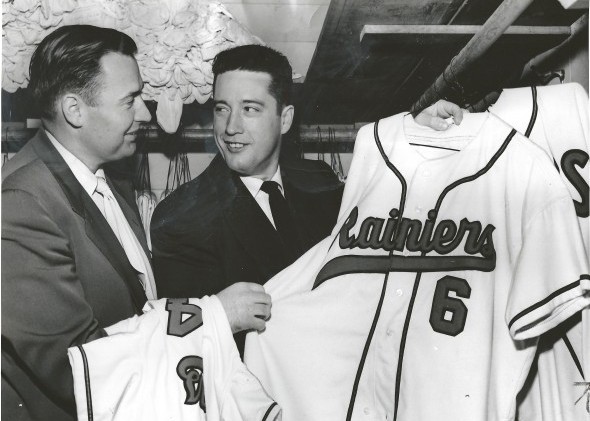
Brightman first served as host of Club Matinee, a 2-5 p.m. weekday show aimed at housewives that featured news, interviews, and gab about music, films and local goings-on. After a few months, Brightman took over as emcee of Hi-Jinks, a high-school variety show that ran from 5-6 p.m. weekday afternoons.
Brightman, who handled an occasional sports broadcast, then became host on a pre-dawn show for night-crawlers and insomniacs titled Als Cellar Café that ran from 1-3 a.m. Wearing an apron, Brightman, a la Rachael Ray, prepared his favorite recipes for viewers. Finally, Brightman hosted a nightly, full-length “Big Money” movie, from 3-5 a.m. — as part of Als Cellar Cafe entertainment.
By late 1956, Brightman had had enough of late-night/early morning TV and moved home to Long Beach to run a restaurant. That didnt pan out, so Brightman went to work at a Douglas Aircraft plant.
Two years after Brightman departed Seattle U., the Washington State job came open when Jack Friel retired after leading the Cougars for 30 years. Brightman lobbied hard and publicly for it, but lost out to former Madigan Generals teammate Harshman, then winding up his 13th season as head coach at Pacific Lutheran University. Brightmans lack of a college degree, and whatever other gossip trailed him, cost him again.
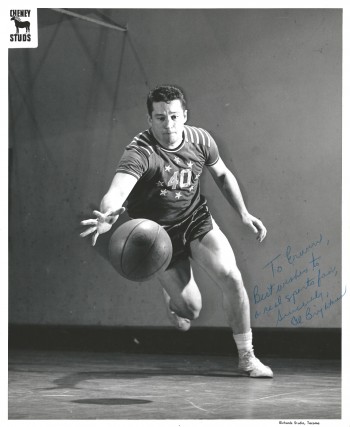
Jolted by the veering of his fortune, Brightman entered Long Beach State University and completed work for a bachelors degree in English.
To make an income, Brightman coached basketball at Garden Grove High School, a long way from Madison Square Garden, and sold automobiles.
Brightman caught a break in 1961 when he was named head coach of the San Francisco Saints of the American Basketball League, founded by Globetrotters owner Abe Saperstein.
Brightman succeeded Phil Woolpert, who had coached Bill Russell and K.C. Jones at the University of San Francisco. A year later, Brightman returned home to coach the Long Beach Chiefs when the ABL expanded into that market.
After the league folded Dec. 31, 1962 (notable ABL players included Bill Bridges, Connie Hawkins, Ken Sears, Larry Siegfried and George Yardley), Brightman gave an interview to The Times in which he said, I have died every year for six years since I left the Chieftains.
Brightman coached high school and AAU ball until 1967 when he became head coach of the Anaheim Amigos of the American Basketball Association. The team had financial backing from singer Pat Boone, but no players of consequence. After losing streaks of six, six and eight games and a 12-24 record, Brightman was fired.
He never did get another basketball job. For a while, he operated a California resort owned by actor Chuck Connors, TVs Rifleman, who had been a teammate on the 1946-47 Boston Celtics.
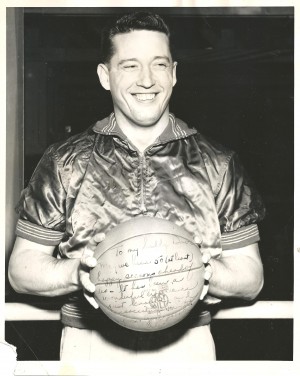
In 1971, Brightman relocated to Maitland, FL., where he worked for Property Management Inc. After two years there, Brightman, wife Katie and their seven children made their final move, to the Portland area, where Brightman spent the remainder of his working life managing apartment houses.
Brightman came down with pancreatic cancer in 1992 and died June 10 that year at 68. Besides Katie, Brightmans survivors included seven children, 15 grandchildren, one great-great grandchild and a brother.
Had Brightman not run afoul of Seattle Universitys Jesuits, he might have become one of college basketballs outstanding coaches. When he departed Seattle University, he had a .726 winning percentage — for comparison purposes, Bobby Knight finished at .706 — with the Elgin Baylor era coming up.
Al Brightman was the kind of guy you’d run through a wall for, said Jim Harney, a Brightman recruit, captain and starting guard on the Seattle U. team that lost to Kentucky in the 1958 NCAA title game.
“For Al, there was never a mountain,” Johnny O’Brien said after Brightman passed away. “Only hills.”
“He lived life to the fullest, added Sears. He was no saint, but he was a fine human being and a great individual.”
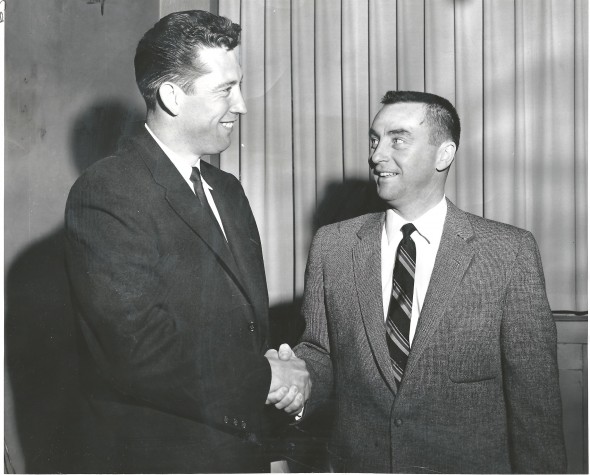
——————————————
Many of the historic images published on Sportspress Northwest are provided by resident Northwest sports history aficionado David Eskenazi. Check out Davids Wayback Machine Archive. David can be reached at (206) 441-1900, or at seattlesportshistory@gmail.com

2 Comments
Thanks again, Dave and Steve, for bringing these stories to present-day fans. I was
a UW student at the time and active in the summers in Bellingham sports, serving among other things as public address announcer and scorer at semi-pro Bellingham Bells baseball games. I saw Brightman play first base, and hit cleanup, for visiting teams. He was a terrific, perhaps major-league-level hitter but had severely hurt his throwing arm and had to
throw low sidearm and could barely get the ball aross the infield. I also saw him play pro basketball there. He was a truly fierce competitor, spirited, and a leader. There also was
a bit of wiseguy cynicism about him.
Rumors were common, at the time of his departure from Seattle U., that he had gotten involved with one or more undergrad female students and the fathers would not tolerate it.
Do not know if the rumors were true but they were generally accepted. It was a sad ending to the career of a good coach and colorful, size-large figure.
Thanks again, Dave and Steve, for bringing these stories to present-day fans. I was
a UW student at the time and active in the summers in Bellingham sports, serving among other things as public address announcer and scorer at semi-pro Bellingham Bells baseball games. I saw Brightman play first base, and hit cleanup, for visiting teams. He was a terrific, perhaps major-league-level hitter but had severely hurt his throwing arm and had to
throw low sidearm and could barely get the ball aross the infield. I also saw him play pro basketball there. He was a truly fierce competitor, spirited, and a leader. There also was
a bit of wiseguy cynicism about him.
Rumors were common, at the time of his departure from Seattle U., that he had gotten involved with one or more undergrad female students and the fathers would not tolerate it.
Do not know if the rumors were true but they were generally accepted. It was a sad ending to the career of a good coach and colorful, size-large figure.